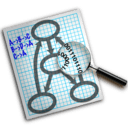Graphviz
Graphviz (short for Graph Visualization Software) is a package of open-source tools initiated by AT&T Labs Research for drawing graphs specified in DOT language scripts. It also provides libraries for software applications to use the tools. Graphviz is free software licensed under the Eclipse Public License.
 | |
| Developer(s) | AT&T Labs Research and contributors[1] |
|---|---|
| Initial release | before 1991[2] |
| Stable release | 2.40.1
/ 25 December 2016[3] |
| Repository | https://gitlab.com/graphviz/graphviz |
| Written in | C |
| Operating system | Linux, macOS, Windows |
| Type | Graph visualization |
| License | Eclipse Public License |
| Website | graphviz |

A red–black tree plotted by Graphviz.

Undirected graph showing adjacency of the 48 contiguous United States
Software architecture
Graphviz consists of a graph description language named the DOT language[4] and a set of tools that can generate and/or process DOT files:
- dot
- a command-line tool to produce layered drawings of directed graphs in a variety of output formats, such as (PostScript, PDF, SVG, annotated text and so on).
- neato
- for "spring model" layout (in Mac OS version called "energy minimised")
- sfdp
- a layout engine for undirected graphs that scales to very large graphs.
- fdp
- another layout engine for undirected graphs.
- twopi
- for radial graph layouts.
- circo
- for circular graph layouts.
- dotty
- a graphical user interface to visualize and edit graphs.
- lefty
- a programmable (in a language inspired by EZ[5]) widget that displays DOT graphs and allows the user to perform actions on them with the mouse. Therefore, Lefty can be used as the view in a model–view–controller GUI application that uses graphs.
- gml2gv - gv2gml
- convert to/from GML, another graph file format.
- graphml2g
- convert a GraphML file to the DOT format.
- gxl2gv - gv2gxl
- convert to/from GXL, another graph file format.
Applications that use Graphviz
- ArgoUML's alternative UML Diagram rendering called argouml-graphviz.[6]
- AsciiDoc can embed Graphviz syntax as a diagram.
- Bison is able to output the grammar as dot for visualization of the language.[7]
- ConnectedText has a Graphviz plugin.
- Doxygen uses Graphviz to generate diagrams, including class hierarchies and collaboration for source code.[8]
- FreeCAD uses Graphviz to display the dependencies between objects in documents.[9]
- Gephi has a Graphviz plugin.
- Gramps uses Graphviz to create family trees.
- Graph-tool a Python library for graph manip and visualization.
- OmniGraffle version 5 and later uses the Graphviz engine, with a limited set of commands, for automatically laying out graphs.[10]
- Org-mode can work with DOT source code blocks.[11]
- PlantUML uses Graphviz to generate UML diagrams from text descriptions.
- Puppet can produce DOT resource graphs that can be viewed with Graphviz.
- Scribus is an Open Source DTP program that can use Graphviz to render graphs by using its internal editor in a special frame type called render frame.[12]
- Sphinx is a documentation generator that can use Graphviz to embed graphs in documents.
- TOra a free software database development and administration GUI, available under the GNU GPL.
- Trac wiki has a Graphviz plugin.[13]
- Visitors is a Web analyzer, no longer maintained, also generating Graphviz files to visualize access paths.
- Vithanco is a visual business analysis tool that uses Graphviz for layout.
- WackoWiki, a wiki with Graphviz Formatter[14]
- WikidPad uses Graphviz as a plugin.
- Zim includes a plugin that allows adding and editing in-page diagrams using the Graphviz dot language.[15]
References
- "Credits Graphviz".
- Eleftherios Koutsofios and Stephen North. Drawing graphs with dot. Technical Report 910904-59113-08TM, AT&T Bell Laboratories, Murray Hill, New Jersey, September 1991.
- "Tags - graphviz / graphviz". Retrieved 23 August 2018 – via GitLab.
- The DOT Language
- The Lefty guide (“Editing Pictures with lefty”), section 3.1, p. 9.
- "argouml-graphviz.tigris.org". argouml-graphviz.tigris.org. Retrieved 15 January 2018.
- Naumann, Uwe (2012). The Art of Differentiating Computer Programs: An Introduction to Algorithmic Differentiation. SIAM. p. 181. ISBN 9781611972078. Retrieved 15 January 2018.
- Anderson, Fritz (2014). Xcode 5 Start to Finish: iOS and OS X Development. Addison-Wesley Professional. p. 425. ISBN 9780133751024. Retrieved 15 January 2018.
- "Std DependencyGraph". FreeCAD web. Retrieved 18 July 2018.
- https://support.omnigroup.com/documentation/omnigraffle/mac/7.6/en/opening-and-importing-files-in-omnigraffle/#supported-dot-syntax
- Voit, Karl. "Org tutorial on generating simple process diagrams using dot and tables". orgmode.org. Retrieved 15 January 2018.
- Gemy, Cedric (2010). Scribus 1.3.5 Beginner's Guide. Packt Publishing Ltd. ISBN 9781849513012. Retrieved 15 January 2018.
- "GraphvizPlugin – Trac Hacks - Plugins Macros etc". trac-hacks.org. Retrieved 15 January 2018.
- "GraphvizPlugin – WackoWiki Hacks - Plugins Macros etc". Retrieved 24 January 2020.
- "Zim - a desktop wiki: Diagram Editor". zim-wiki.org. Retrieved 15 January 2018.
External links
- Official website

- graphviz on GitLab
- Graphviz, Projects & Software Page, AT&T Labs Research
- An Introduction to Graphviz and dot (M. Simionato, 2004)
- Create relationship diagrams with Graphviz (Shashank Sharma, 2005)
- Webgraphviz, port of Graphviz for JavaScript running in a Web browser
- Gravizo online graph image generator to embed directly on Web page or a "readme" file. Can generate Graphviz, PlantUML and UMLGraph
- graphviz, running and saving Graphviz on the desktop or mobile browser
This article is issued from Wikipedia. The text is licensed under Creative Commons - Attribution - Sharealike. Additional terms may apply for the media files.